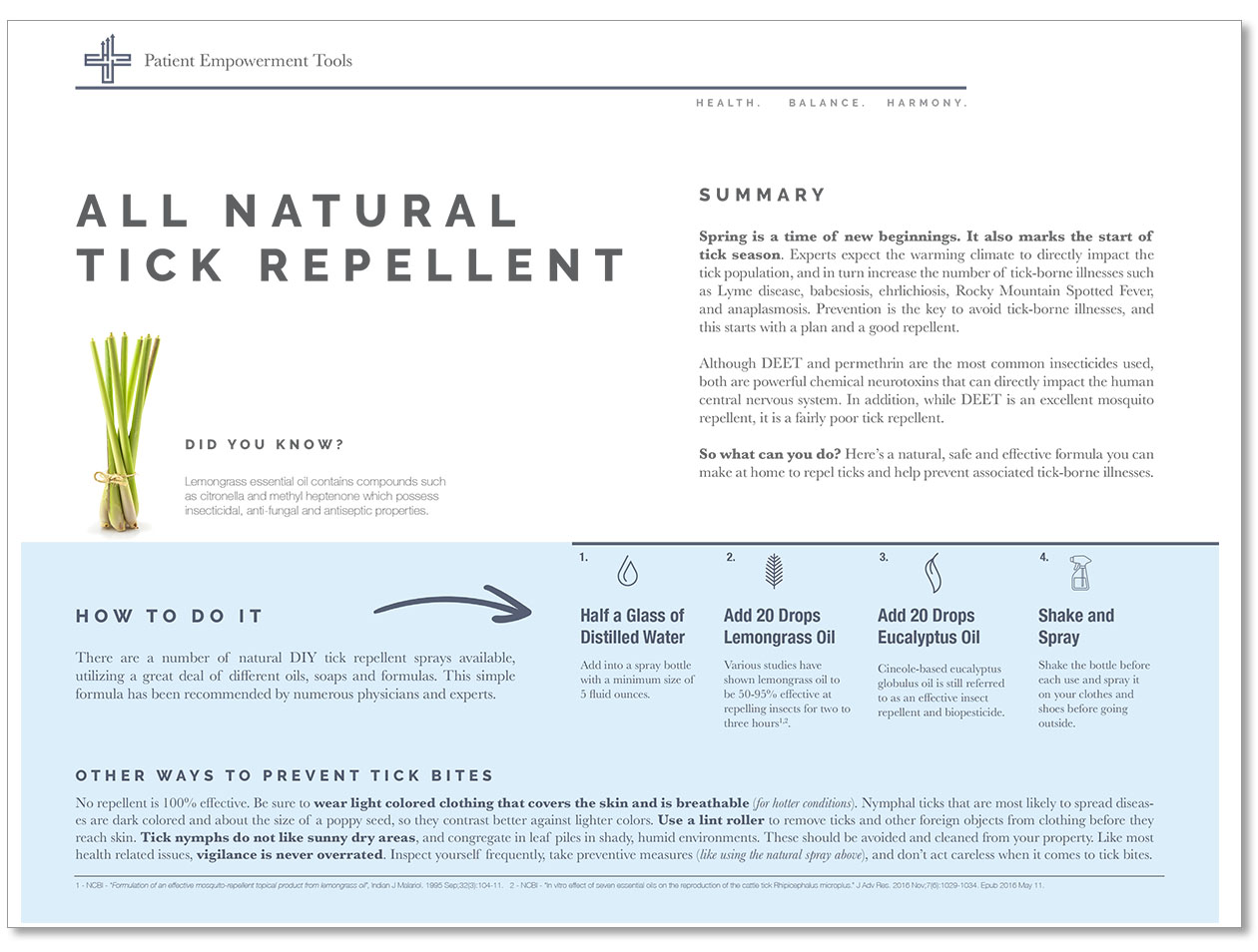Winter is finally over, and spring is upon us; which also means it’s tick season. Many of us would think the snow storm that hit much of the country in late March would be a good thing to diminish tick population that thrive in warmer weather. Unfortunately, the opposite is happening. Experts are expecting an increase in ticks this spring season, suggesting that the snow from this past winter acted as a protective sheet for young blacklegged ticks, which will now arise in the warm weather and spread diseases such as Lyme disease, babesiosis, ehrlichiosis, Rocky Mountain Spotted Fever, anaplasmosis, Southern Tick-Associated Rash Illness, Tick-Borne Relapsing Fever, and tularemia. Prevention is the key to avoid tick-borne illnesses, and this starts with a plan and a good repellent.
The Conventional Route
Although there are many conventional sprays one can use to repel ticks, most of us utilize insecticide sprays that contain DEET (N,N-Diethyl-meta-toluamide) as the main ingredient. For those that do not know, DEET is a powerful chemical neurotoxin that can directly impact the central nervous system. Studies have shown that DEET causes brain cell death and behavioral changes in rats after frequent and prolonged use. And for many with already compromised immune systems and high toxicity, the use of DEET can be especially harmful. In addition, while DEET is an excellent mosquito repellent, it is a fairly poor tick repellent.
Another compound less commonly used to prevent tick bites is permethrin. This insecticide is derived from a chemical found in the chrysanthemum family of plants. After being applied externally on clothing, permethrin works primarily by killing ticks on contact with the clothes and can provide high levels of protection against tick bites. While permethrin is said to be safer than DEET for humans due to application to clothes only (not to skin), it is very toxic to a number of animals, including cats and fish, and still a neurotoxin that if comes in contact with skin can have negative effects on the body and nervous system.
It is always our stance at Innovative Medicine to take a more holistic approach that minimizes detrimental side-effects and utilizes natural methods to prevent disease. With this in mind, we’ve used our network of practitioners and experts to design a simple, safe and effective natural tick repellent spray.
Two of Nature’s Best Tick Repellents
There are a number of natural DIY tick repellent sprays available, utilizing a great deal of different oils, soaps and formulas. After consulting tick experts, we found the simplest solution may also be the best.
20 Drops of Lemongrass Oil

Lemongrass (Cymbopogon citratus) is an herb which belongs to the grass family of Poaceae. It is well known and utilized for its distinct lemon flavor and citrusy aroma. It is a tall, perennial grass which is native to India and tropical regions of Asia. What makes it effective in the prevention of ticks is what is in it. Lemongrass essential oil contains compounds such as citronella, nerol, myrcene, dipentene, geraniol and methyl heptenone which possess anti-fungal, insecticidal and antiseptic properties.
In addition, studies have shown that lemongrass essential oil has an anti-biofilm capacity. Biofilms are groups or masses of microorganisms capable of attaching to virtually any surface. According to the NIH, they factor into nearly 80% of all bacterial infections and are inherently resistant to antibiotics. Biofilms are thought to be a contributing factor to the difficulty in eradicating Lyme disease. Lemongrass oil, which contains phenols, possesses the capability to spread quickly through the body tissues and cure biofilms located anywhere in the body. The topical application of lemongrass is said to act as a repellent to both biofilms and organisms that may contain associated pathogens (e.g., Borrellia, Mycoplasma, Bartonella, Babesia, Rickettsia).
20 Drops of Eucalyptus Globulus Oil

Eucalyptus (Eucalyptus globulus) leaf has long been used in herbal medicine for infections, fever, upset stomach, and respiratory condition. One study out of Germany found that the compound cineole, commonly found in eucalyptus essential oil, is an effective long-term therapy to help control COPD (chronic obstructive pulmonary disease) symptoms and improve asthma. The oil of eucalyptus also possesses a wide spectrum of biological activity including anti-microbial, fungicidal, insecticidal/insect repellent, herbicidal, acaricidal and nematicidal.
First registered in the United States as an insecticide and miticide in 1948, cineole-based eucalyptus globulus oil is still referred to as an effective insect repellent and biopesticide. In one research paper, entitled “Eucalyptus essential oil as a natural pesticide“, the authors go on to say, “the use of eucalyptus oil as a natural pesticide is of immense significance in view of the environmental and toxicological implications of the indiscriminate use of synthetic pesticides and overcoming/reducing the problem of increasing pest resistance.“
» Purchase Eucalyptus Globulus Oil
Making a Spray
Utilizing half a cup of distilled water, combine the 20 drops of lemongrass oil together with the 20 drops of eucalyptus globules oil into a spray bottle and shake vigorously. The highly aromatic spray can be applied directly to all areas of clothing and skin before participating in outdoor activities or entering areas where ticks may be present.
Download the “All Natural Tick Repellent” Guide (pdf)
Other Precautions to Take
Wear the Right Gear
It may be counterintuitive during the warm Spring and hot Summer months, but wear clothes that do not leave skin exposed. Wear natural, breathable pants, tuck socks into the pants for another layer of protection, and go with lighter colors. Nymphal ticks that are most likely to spread diseases are dark colored and about the size of a poppy seed, so you can to be able to identify them against a lighter color to quickly remove them before they reach skin.
Practice Landscape Hygiene
While you do not have control over many of the areas one can expect to find ticks, you do have control of your backyard and property. Tick nymphs congregate in leaf piles in shady, humid environments. This can include shrubs and unkempt areas near the house. They do not however like sunny areas and low cut grass areas. In addition, ticks won’t cross a barrier of wood chips placed around the yard’s perimeter, most likely due to the dry environment that they cannot survive in. So practice landscape hygiene and remove areas where ticks are most likely to congregate.
Be Vigilant
Like most things that are related to health, vigilance is never overrated. Inspect yourself frequently, take preventive measures (like using the natural spray above), and don’t act careless when it comes to tick bites. Even one bite can lead to a chronic debilitating illness that is often very difficult to overcome (or perhaps not that difficult with the right approach).
* Disclaimer: The statements made in this article have not been evaluated by the Food and Drug Administration. Any products or treatments mentioned are not intended to diagnose, treat, cure, or prevent any disease. Please consult a licensed medical practitioner for medical advice. At Innovative Medicine, we believe in transparency. We want you to know that we may participate in affiliate advertising programs pertaining to products mentioned herein.






